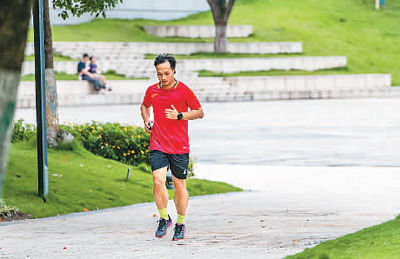
A few days ago, a citizen ran in Chongqing Binjiang Park. Tang Yishe (Xinhua News Agency)
Stress fractures, also known as fatigue fractures or cumulative strain injuries, are bone injuries caused by overuse. When the muscles are overused and fatigued, the vibrations generated by repeated collisions cannot be absorbed in time, and the stress is transmitted to the bones, which can cause small bone cracks or fractures, accompanied by local swelling and pain. After a stress fracture occurs, about 20% of people experience movement impairment.
The risk factors for stress fracture mainly include insufficient energy intake, bone damage, lack of vitamin D in the body, unreasonable arrangement of running content, etc. Other influencing factors include the runner’s age, height, weight, etc.
In view of the risk factors of stress fracture, it is particularly important to actively take the following measures.
Have a balanced meal with enough calories. Long-distance running will consume a lot of energy. It is recommended to supplement sufficient carbohydrate-rich cereals, potato foods and sports drinks (containing carbohydrates and electrolytes) 2-4 hours before running to ensure liver glycogen and muscle glycogen reserves. . In the 90 minutes after the high-intensity exercise, the synthesis rate of glycogen is relatively fast. At this time, it is necessary to supplement an appropriate amount of carbohydrates to promote the recovery of glycogen.
Vitamin D supplementation. Vitamin D is necessary to maintain bone health, it can promote the body’s absorption of calcium and protect bones. In daily life, vitamin D is mainly synthesized by the human skin after being irradiated by ultraviolet rays, and a small part is ingested from food or supplements. After long-distance running, a single dietary supplement of vitamin D is sometimes difficult to meet the body’s needs. It is usually recommended to supplement 400IU-800IU (international units) of vitamin D every day after running.
Rational arrangement of running content. It is recommended to do 5-10 minutes of warm-up and muscle stretching before running, and incorporate strength training into daily exercise, especially to strengthen the muscle strength exercises of the feet and calves where stress fractures are prone to. It is recommended to schedule muscular endurance and strength exercises twice a week. Each major muscle group should be trained 2-4 sets of 8-12 repetitions, with 2-3 minutes of rest between sets. In addition, cross-training can be arranged twice a week, and the training content can be selected from swimming, cycling, etc. Cross-training is an effective means for many of the world’s top runners to prevent running injuries. If your muscles continue to be sore after a long-distance run, you need to reduce the amount of exercise or rest, so that your body can gradually adapt to the rhythm of running.
If symptoms of stress fracture are found, exercise should be reduced or stopped. Blind use of pain relievers, especially non-steroidal anti-inflammatory drugs such as ibuprofen, is not recommended unless advised by a doctor. When the symptoms of stress fracture occur, it is recommended to adopt the “R.I.C.E.” method: R (Rest) rest, I (Ice) ice pack, C (Compress) compression dressing and E (Elevation) elevation of the affected limb. Usually, an ice pack is applied to the injured area for 15 minutes at a time, with an interval of 2-3 hours each time. Be careful not to apply ice directly to the injured area, so as not to cause local skin frostbite; the pressure bandage of the injured area should not be too tight, otherwise it will cause Impaired blood circulation; elevating the affected limb above the heart can help reduce swelling in the injured area. Stress fractures are divided into two types: low-risk and high-risk. Low-risk stress fractures can promote fracture healing by reducing activity or other physical therapy methods, but for high-risk stress fractures, an orthopaedic doctor should be actively booked for diagnosis and treatment.
(The author is the deputy director of the Sports Injury Prevention and Rehabilitation Research Center, Institute of Sports Medicine, General Administration of Sport of China)